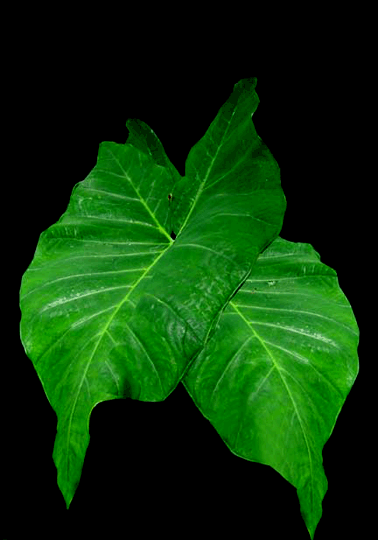![]()
Aroids and other genera in the Collection
Take the Tour Now?
Orchids
The
Exotic Rainforest
Images on this website are copyright protected. Contact us before
any reuse.
Xanthosoma sagittifolium (L.) Schott

Arrowleaf "Elephant Ear", Malanga, Yautia, Tannia, Mangarás, New Cocoyam, Tajer, Tanier, Taioba, Chou Caribe, Cascamote
and many other common names.
I used to walk through the produce aisles of grocery stores in South Florida and would always see these enormous tubers (a subterranean round to elongated fleshy rhizome which serves as a storage organs) called "Malanga". I had no idea "Malanga" was Xanthosoma sagittifolium. I knew it must be edible because people, especially Hispanics and the folks of Caribbean descent, would always be ing the produce. It took me a long time to ask someone how the tuber was used. The answer, "just about everything"! Hispanics and the people from the Caribbean and South or Central America who live in Miami use it as a staple starch in their diet.
These tubers (incorrectly called a bulb or corm) grow underground and can become very large. They are a primary carbohydrate throughout much of the Caribbean, especially Trinidad, Surinam, Cuba and Latin countries. The corm or tuber is eaten grilled, fried, as puree in soups or barbecued whole. The young leaves and shoots of Xanthosoma sagittifolium are valued as a boiled vegetable as are the fresh stems, tubers, and peelings which are eaten almost daily. Xanthosoma species are known to be highly variable and not every leaf of every specimen will always appear the same. This link explains in greater detail the scientific principle of natural variation and morphogenesis. Click here.
Xanthosoma sagittifolium originated in the jungles of southern Central America, Venezuela, French Guiana, Colombia, Ecuador, Peru, Brazil and other South American nations and spread quickly throughout most of the Caribbean. Although it is considered "invasive" in South Florida it is commonly grown in large fields, which most people call simply "Elephant ears", to satisfy the needs of Florida's varied Latin and Caribbean communities. The plant easily grows to 2 meters plus (6 or 7 feet) and we've seen a few plants used in yards as a landscape plant at 3 meters (9 feet) or even taller since they are regularly groomed and fertilized. However, Xanthosoma sagittifolium is not typically grown as a landscape plant, but rather a food product.
Xanthosoma sagittifolium is an aroid and a member of the Arum family. The Xanthosoma (zan-tho-SOM-a) resembles wild Taro which is an invasive plant in South Florida that is used in many Caribbean nations for food. The leaves of the Malanga can get extremely large, and as a result, makes an impressive tropical plant in a garden landscape. The leaves are quite fragile and easily torn so the plant should be protected from wind. It is grown as a food crop in full sun but reaches a more impressive height if grown in light shade. The plant reproduces by either producing a spathe inflorescence or growing "pups" from its' base. Some claim you can grow it as far north as Zone 8.
Xanthosoma sagittifolium does make an impressive "Elephant Ear" when used as a landscape plant. However, the term "Elephant Ear" is a poor descriptive term. That term is sometimes applied to five, perhaps six, groups of plants (genera) that include multiple thousands of species! Those genus include Alocasia, Philodendron, Anthurium, Colocasia, Xanthosoma, and a few Caladium species. So if you ask about an "Elephant Ear", which species do you mean? All of those species are quite different and often grow in very different ways.
I've found photos of several other plants labeled as Xanthosoma sagittifolium on the internet. Scientifically, the species is often confused with many other species. I'm relatively certain the ID given to me is correct since it was given by a South Florida grower with huge fields of the plants. If you wish to grow it outdoors in cold climates bring the corm indoors for the winter. Our plant often goes to a near dormant state for the winter but in spring 1 meter (3 foot) leaves, which will reach well over 1.3 meters (4 feet), develop in just a few months.
 The
finest aroids in Ecuador available direct to any collector!
The
finest aroids in Ecuador available direct to any collector!
http://www.ecuagenera.com//Tropical Plants/Araceae
Want to learn more
about aroids?
Join the
International Aroid Society:
http://www.exoticrainforest.com/Join%20IAS.html